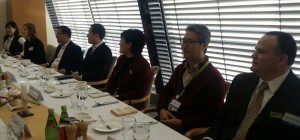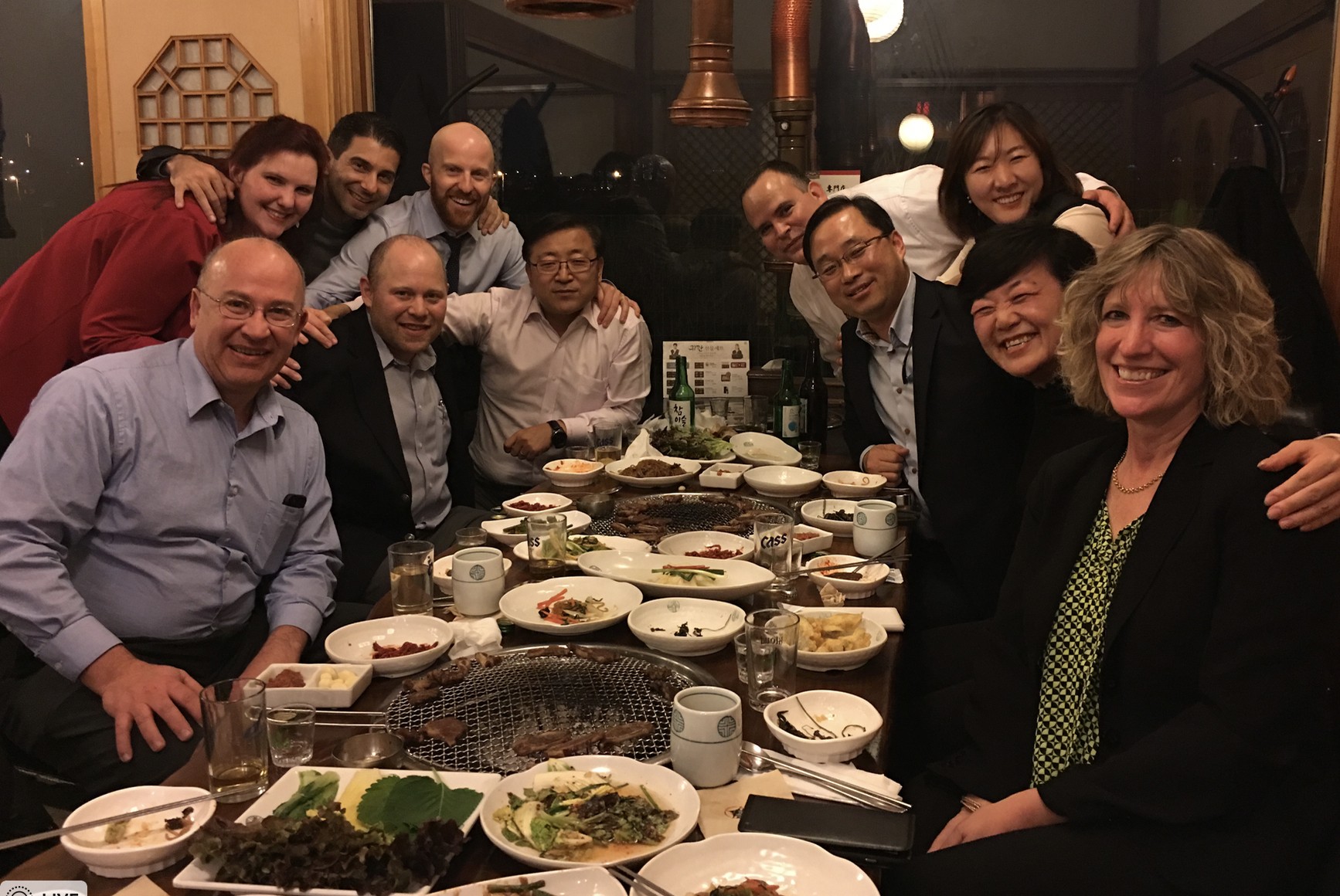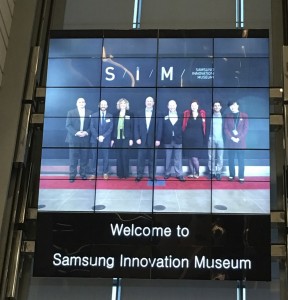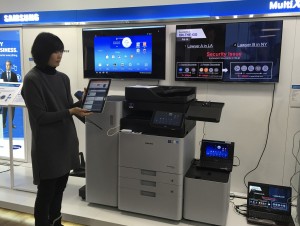By Andy Slawetsky – Last week I had the privilege of visiting Samsung’s HQ in South Korea with several other US analysts. It was an amazing experience and Samsung treated us like rock stars, showing us not only what the technology behemoth is up to, but providing us with a great taste of South Korean culture.
 South Korea is a pretty cool country. It’s got a great sense of history, customs and traditions but it’s also extremely tech-driven. It’s listed on the top 5 most high tech countries along with the likes of the US and Japan. Even the hotel toilet seat plugged in (seriously)!
South Korea is a pretty cool country. It’s got a great sense of history, customs and traditions but it’s also extremely tech-driven. It’s listed on the top 5 most high tech countries along with the likes of the US and Japan. Even the hotel toilet seat plugged in (seriously)!
 After a long journey, the meetings started Wednesday morning. We certainly received the royal treatment; unlike most people, including Samsung employees, we were actually allowed to bring cameras and recording devices into the building. This is a pretty big deal and it’s clear that although Samsung takes security very seriously, they really want to get the word out on their printer program.
After a long journey, the meetings started Wednesday morning. We certainly received the royal treatment; unlike most people, including Samsung employees, we were actually allowed to bring cameras and recording devices into the building. This is a pretty big deal and it’s clear that although Samsung takes security very seriously, they really want to get the word out on their printer program.
We began the morning when VP Anna Cho provided an overview on Samsung. Here’s a snapshot. Samsung has 60,495 R&D employees. That’s more than the global headcount of some competitors. These employees work in 34 R&D centers around the world and I may have got this wrong, but the annual investment is $14B (US). That’s unreal. They’re always developing.
After the background review Anna spoke at length about the Smart UX platform – Samsung’s tablet-like user interface (touch screen) found on their current A3 and A4 copiers/printers. This UI is great on so many levels. First of all, it looks exactly like a smart phone screen. No layers, just apps. It’s clean and very easy to locate features. Anyone that has a smart phone (70+% of adults at last count) will know how to use the basics on these devices without any training.
Then there’s the fact that it’s an Android tablet. This means anyone who can develop apps can develop something for this UI – partners, dealers and even customers. Their business app center has 33 apps in it with over 56,000 downloads. There’s even an optional connector on the home screen to help expose the customer to available apps they may not yet own. This could be a nice revenue stream as it continues to build. It’s also a potential revenue stream for dealers that come up with useful apps on their own.
 Samsung is making considerable efforts to integrate the device and the UI in ways that competitors haven’t. Unique partnerships with PrintFleet and Nuance as well as PrinterOn, acquired by Samsung in 2014 have shown promise in integrating solutions into the UI and even the hardware. While they were late to the game with respect to solutions and partners, they have quickly caught up over the last couple of years.
Samsung is making considerable efforts to integrate the device and the UI in ways that competitors haven’t. Unique partnerships with PrintFleet and Nuance as well as PrinterOn, acquired by Samsung in 2014 have shown promise in integrating solutions into the UI and even the hardware. While they were late to the game with respect to solutions and partners, they have quickly caught up over the last couple of years.
Samsung is the only print manufacturer that has full in-house sourcing for all parts of the device. All components in Samsung’s MFPs were made by Samsung, giving them a unique advantage over other brands. Everything from the chemicals to the semi conductors to the software (and scanners, fusers, finishers, drums, controllers…) was manufactured and developed in-house. I’ve heard techs tell me they like working on Samsung devices because the boards are so accessible and the devices are laid out well inside.
 We got to spend some time in Samsung’s QA labs where we saw some audio tests. Each product receives 22 different electrical tests, 78 operational tests, 109 long-term reliability tests, 76 image quality tests and 20 environmental tests. This is quite a process and an impressive attention to quality at the manufacturing end.
We got to spend some time in Samsung’s QA labs where we saw some audio tests. Each product receives 22 different electrical tests, 78 operational tests, 109 long-term reliability tests, 76 image quality tests and 20 environmental tests. This is quite a process and an impressive attention to quality at the manufacturing end.
Later, we sat in a brainstorming session. I haven’t had a vendor ever do this before and it was very cool. Samsung brought several engineers/executives into a room and sat them across from us. On my side were representatives from BPO Media, The Cannata Report, IDC, GAP Intelligence, BLI and myself. The next 90 minutes consisted of them asking us all sorts of questions about their technology, what we thought of their approaches, what we didn’t like, market need, competitiveness and more.
 Later, we took a tour of the showroom where we were given product demonstrations on Samsung’s service app. I’ve seen this in use in my million page test and I can tell you the techs love it. They can tether their smart phone via USB cable or Wi-Fi to the MFP to go through the service items. It makes going through codes very easy and fast. There’s video help available through the app, making it even more effective.
Later, we took a tour of the showroom where we were given product demonstrations on Samsung’s service app. I’ve seen this in use in my million page test and I can tell you the techs love it. They can tether their smart phone via USB cable or Wi-Fi to the MFP to go through the service items. It makes going through codes very easy and fast. There’s video help available through the app, making it even more effective.
I also noticed some concept machines in this room. Could these be the future of copiers? You can see a couple in the event pictures.
 The next day we had several one-on-one meetings with senior executives; Anna Cho, VP, Head of Marketing, David Song, SVP, Strategic Sales and Marketing, Kasey Kim, VP SW & Solution Development, Harris Han, VP, Head of SW and Chin Yoon, VP Sales and Marketing all gave each of us a considerable amount of time where we discussed topics relevant to their areas work. The execs were very open with me and the conversations were very interesting. I learned a lot about Samsung and where they’re heading.
The next day we had several one-on-one meetings with senior executives; Anna Cho, VP, Head of Marketing, David Song, SVP, Strategic Sales and Marketing, Kasey Kim, VP SW & Solution Development, Harris Han, VP, Head of SW and Chin Yoon, VP Sales and Marketing all gave each of us a considerable amount of time where we discussed topics relevant to their areas work. The execs were very open with me and the conversations were very interesting. I learned a lot about Samsung and where they’re heading.
The meetings ended with a presentation from a group of engineers who showed us some incite into Samsung’s process. It was impressive and we were able to see some pretty interesting concept machines that I really am not allowed to describe. They were very cool.
Samsung has built a solid portfolio but like other brands, they will always be challenged with taking market share from competitors. Dealers have sunken costs with current “primary” brands and they don’t just jump from brand to brand. Penetrating and growing organically with dealers is a grind. For you to win, someone has to lose. The easy way to grow is through an acquisition. Maybe this is in their future?
 There’s a lot to like about Samsung. The market is not saturated with their brand, they have no direct sales force competing against dealers and they have a great A4 line as well as a capable A3 portfolio. I think in many cases, dealers want to sell Samsung but they need Samsung to fit in better with their current business models. Dealers have a way they’ve become used to doing business over the last half century and B2B is different than B2C. Dealers have certain expectations and they’re all independent businesses. As Samsung continues to improve in this channel, working on relationships with dealers is just as important as building an excellent MFP.
There’s a lot to like about Samsung. The market is not saturated with their brand, they have no direct sales force competing against dealers and they have a great A4 line as well as a capable A3 portfolio. I think in many cases, dealers want to sell Samsung but they need Samsung to fit in better with their current business models. Dealers have a way they’ve become used to doing business over the last half century and B2B is different than B2C. Dealers have certain expectations and they’re all independent businesses. As Samsung continues to improve in this channel, working on relationships with dealers is just as important as building an excellent MFP.
 Samsung was very interested to learn what they can do to improve. They’re always moving forward. They are steadily working towards this goal and, while they may hit a bump along the way now and then, they have consistently improved. That said, there are still areas Samsung knows they need to address and they discussed these openly with us. I liked that about these executives. They genuinely wanted to know what we thought and they weren’t defensive about our answers.
Samsung was very interested to learn what they can do to improve. They’re always moving forward. They are steadily working towards this goal and, while they may hit a bump along the way now and then, they have consistently improved. That said, there are still areas Samsung knows they need to address and they discussed these openly with us. I liked that about these executives. They genuinely wanted to know what we thought and they weren’t defensive about our answers.
On another note, something I liked about the Korean culture is the empowerment of women. It was noticeable. The majority of people in the engineering presentation were women. Our host Anna Cho is a VP in charge of their Marketing program. The captain of our Korean Air Airbus A380-800 was a woman as well. Korea is not the “boys club” of other cultures, including my own at times.
I appreciate the invitation to visit with Samsung to learn about their culture and their company. One thing is clear. Samsung is too big to fail and they refuse to lose. The Korean culture is very competitive and this company fits that mantra. Considering they just entered the A3 market about five years ago, they have made great strides. Can they take it to the next level? Time will tell; they need to figure out how to increase distribution. They have the products, they have the power of a stable and healthy company behind them and one of the best brands in the world. Keep an eye on these guys.
~Andy


